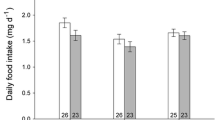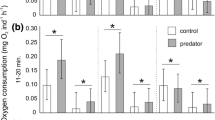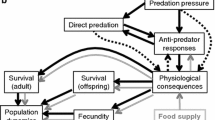Abstract
The important ecological role of predation risk in shaping populations, communities and ecosystems is becoming increasingly clear. In this context, synergistic effects between predation risk and other natural stressors on prey organisms are gaining attention. Although non-pathogenic bacteria can be widespread in aquatic ecosystems, their role in mediating effects of predation risk has been ignored. We here address the hypothesis that non-pathogenic bacteria may reinforce the negative effects of predation risk in larvae of the damselfly Coenagrion puella. We found synergistic effects for all three life history variables studied: mortality increased, growth reductions were magnified and bacterial load was higher when both non-lethal stressors were combined. The combined exposure to the bacterium and predation risk considerably impaired the two key antipredator mechanisms of the damselfly larvae: they no longer reduced their food intake under predation risk and showed a synergistic reduction in escape swimming speed. The reinforcing negative effects on the fitness-related traits could be explained by the observed synergistic effects on food intake, swimming muscle mass, immune function and oxidative damage. These are likely widespread consequences of energetic constraints and increased metabolic rates associated with the fight-or-flight response. We therefore hypothesize that the here documented synergistic interactions with non-pathogenic bacteria may be widespread. Our results highlight the ignored ecological role of non-pathogenic bacteria in reinforcing the negative effects of predation risk on prey organisms.



Similar content being viewed by others
References
Ahmed AM, Baggot SL, Maingon R, Hurd H (2002) The costs of mounting an immune response are reflected in the reproductive fitness of the mosquito Anopheles gambiae. Oikos 97:371–377
Ansa EDO, Lubberding HJ, Ampofo JA, Gijzen H (2011) The role of algae in the removal of Escherichia coli in a tropical eutrophic lake. Ecol Eng 37:317–324
Aquafin (2012) Uitvoering zwemwaterrichtlijn vermindert kustvervuiling. Aqua 1:10–12
Baik SC, Youn HS, Chung MH, Lee WK, Cho MJ, Park CK, Kasai H, Rhee KH (1996) Increased oxidative DNA damage in Helicobacter pylori-infected human gastric mucosa. Cancer Res 56:1279–1282
Beckerman AP, Wieski K, Baird DJ (2007) Behavioural versus physiological mediation of life history under predation risk. Oecologia 152:335–343
Benard MF (2004) Predator-induced phenotypic plasticity in organisms with complex life histories. Annu Rev Ecol Evol Syst 35:651–673
Bligh EG, Dyer WJ (1959) A rapid method of total lipid extraction and purification. Can J Biochem Phys 37:911–917
Bradford MM (1976) A rapid and sensitive method for the quantification of microgram quantities of protein, utilizing the principle of protein-dye landing. Anal Biochem 72:248–254
Campero M, Slos S, Ollevier F, Stoks R (2007) Sublethal pesticide concentrations and predation jointly shape life history: behavioral and physiological mechanisms. Ecol Appl 17:2111–2122
Castex M, Lemaire P, Wabete N, Chim L (2009) Effect of dietary probiotic Pediococcus acidilactici on antioxidant defences and oxidative stress status of shrimp Litopenaeus stylirostris. Aquaculture 294:306–313
Corbet PS (1999) Dragonflies: behavior and ecology of Odonata. Comstock, New York
Darling ES, Côté IM (2008) Quantifying the evidence for ecological synergies. Ecol Lett 11:1278–1286
Dayton GH, Saenz D, Baum KA, Langerhans RB, DeWitt TJ (2005) Body shape, burst speed and escape behavior in larval anurans. Oikos 111:582–591
De Block M, Stoks R (2004) Cannibalism-mediated life history plasticity to combined time and food stress. Oikos 106:587–597
Decaestecker E, De Meester L, Ebert D (2002) In deep trouble: habitat selection constrained by multiple enemies in zooplankton. PNAS 99:5481–5485
Espinoza-Urgel M, Kolter R (1998) Escherichia coli genes expressed preferentially in an aquatic environment. Mol Microbiol 28:325–332
Freitak D, Wheat CW, Heckel DG, Vogel H (2007) Immune system responses and fitness costs associated with consumption of bacteria on larvae of Trichoplusia ni. BMC Biol 5:56
Freitak D, Heckel DG, Vogel H (2009) Bacterial feeding induces changes in immune-related gene expression and has trans-generational impacts in the cabbage looper (Trichoplusia ni). Front Zool 6. doi:10.1186/1742-9994-6-7
Gonzalez-Santoyo I, Cordoba-Aguilar A (2012) Phenoloxidase: a key component of the insect immune system. Entomol Exp Appl 142:1–16
Guerra C, Zenteno-Savin T, Maeda-Martinez AN, Abele D (2013) The effect of predator exposure and reproduction on oxidative stress parameters is the Catarina scallop Argopecten ventricosus. Comp Biochem Physiol A 165:89–96
Guerrero-Beltran JA, Barbosa-Canovas GV (2005) Reduction of Saccharomyes cerevisiae, Escherichia coli and Listeria innocua in apple juice by ultraviolet light. J Food Process Eng 28:437–452
Haislip NA, Hoverman JT, Miller DL, Gray MJ (2012) Natural stressors and disease risk: does the threat of predation increase amphibian susceptibility to ranavirus? Can J Zool 90:893–902
Halliwell B, Gutteridge JMC (2007) Cellular responses to oxidative stress: adaptation, damage, repair, senescence and death. In: Free radicals in biology and medicine, 4th edn. Oxford University Press, New York, pp 260–267
Hawlena D, Kress H, Dufresne ER, Schmitz OJ (2011) Grasshoppers alter jumping biomechanics to enhance escape performance under chronic risk of spider predation. Funct Ecol 25:279–288
Iserbyt A, Van Gossum H, Stoks R (2012) Biogeographical survey identifies consistent alternative physiological optima and a minor role for environmental drivers in maintaining a polymorphism. PLoS One 7:e32648
Janssens L, Stoks R (2012) How does a pesticide pulse increase vulnerability to predation? Combined effects on behavioral traits and escape swimming. Aquat Toxicol 110–111:91–98
Janssens L, Stoks R (2013a) Predation risk causes oxidative damage in prey. Biol Lett 9:20130350
Janssens L, Stoks R (2013b) Synergistic effects between pesticide stress and predator cues: conflicting results from life history and physiology in the damselfly Enallagma cyathigerum. Aquat Toxicol 132–133:92–99
Janssens L, Stoks R (2013c) Exposure to a widespread non-pathogenic bacterium magnifies sublethal pesticide effects in the damselfly Enallagma cyathigerum: from the suborganismal level to fitness-related traits. Environ Pollut 177:143–149
Janssens L, Stoks R (2014) Non pathogenic aquatic bacteria activate the immune system and increase predation risk in damselfly larvae. Freshwater Biol 59:417–426
Karatas F, Karatepe M, Baysar A (2002) Determination of free malondialdehyde in human serum by high-performance liquid chromatography. Anal Biochem 311:76–79
Kelly CD (2011) Reproductive and physiological costs of repeated immune challenges in female Wellington tree weta (Orthoptera: Anostostomatidae). Biol J Linn Soc 104:38–46
Kerby JL, Hart AJ, Storfer A (2011) Combined effects of virus, pesticide and predator cue on the larval tiger salamander (Ambystoma tigrinum). EcoHealth 8:46–54
Kerfoot WC, Sih A (1987) Predation, direct and indirect impacts on aquatic communities. In: Kerfoot WC, Sih A (eds). Hannover University Press, New England
Kirschner AKT, Velimirov B (1997) A seasonal study of bacterial community succession in a temperate backwater system, indicated by variation in morphotype numbers, biomass, and secondary production. Microb Ecol 34:27–38
Kulkoyluoglu O, Dugel M, Kilic M (2007) Ecological requirements of Ostracoda (Crustacea) in a heavily polluted shallow lake, Lake Yenicaga (Bolu, Turkey). Hydrobiologia 585:119–133
Leff LG, Lemke MJ (1998) Ecology of aquatic bacterial populations: lessons from applied microbiology. J N Am Benthol Soc 17:261–271
Liu XL, Sun ZJ, Chong W, Sun ZT, He CK (2009) Growth and stress responses of the earthworm Eisenia fetida to Escherichia coli O157:H7 in an artificial soil. Microb Pathogen 46:266–272
McCauley SJ, Rowe L, Fortin MJ (2011) The deadly effects of “nonlethal” predators. Ecology 92:2043–2048
McEwen HA, Leff LG (2001) Colonisation of stream macroinvertebrates by bacteria. Arch Hydrobiol 151:51–65
McPeek MA, Schrot AK, Brown JM (1996) Adaptation to predators in a new community: swimming performance and predator avoidance in damselflies. Ecology 77:617–629
McPeek MA, Grace M, Richardson JML (2001) Physiological and behavioral responses to predators shape the growth/predation risk trade-off in damselflies. Ecology 82:1535–1545
Miyamoto S, Alves de Almeida E, Nogueira L, Gennari de Medeiros MH, Di Mascio P (2011) Evaluation of malondialdehyde levels. In: Abele J, Vazquez-Medina JP, Zenteno-Savin T (eds) Oxidative stress in aquatic ecosystems. Wiley Blackwell, Oxford, pp 440–447
Monaghan P, Metcalfe NB, Torres R (2009) Oxidative stress as a mediator of life history trade-offs: mechanisms, measurements and interpretation. Ecol Lett 12:75–92
Palijan G (2012) Abundance and biomass responses of microbial food web components to hydrology and environmental gradients within a floodplain of the river Danube. Microb Ecol 64:39–53
Pauwels K, Stoks R, De Meester L (2005) Coping with predator stress: interclonal differences in induction of het-shock proteins in the water flea Daphnia magna. J Evol Biol 18:867–872
Pauwels K, Stoks R, De Meester L (2010) Enhanced anti-predator defence in the presence of food stress in the water flea Daphnia magna. Funct Ecol 24:322–329
Peacor SD, Pangle KL, Schiesari L, Werner EE (2012) Scaling-up anti-predator phenotypic responses of prey: impacts over multiple generations in a complex aquatic community. Proc R Soc B 279:122–128
Preisser EL, Bolnick DI, Bernard MF (2005) Scared to death? The effects of intimidation and consumption in predator-prey interactions. Ecology 86:501–509
Reilly N, Poylin V, Menconi M, Onderdonk A, Bengmark S, Hasselgren PO (2007) Probiotics potentiate IL-6 production in IL-1 beta-treated Caco-2 cells through a heat shock-dependent mechanism. Am J Physiol 293:R1169–R1179
Rigby MC, Jokela J (2000) Predator avoidance and immune defence: costs and trade-offs in snails. Proc R Soc B 267:171–176
Shaked Y, Rose A (2013) Seas of superoxide. Science 340:1176–1177
Slos S, Stoks R (2008) Predation risk induces stress proteins and reduces antioxidant defense. Funct Ecol 22:637–642
Smith VH, Holt RD (1996) Resource competition and within-host disease dynamics. Trends Ecol Evol 11:386–389
Steinberg ECW (2012) Defense means against pathogens and parasites: reactive oxygen species. In: Stress ecology: environmental stress as ecological driving force and key player in evolution. Springer, Dordrecht, pp 47–60
Stoks R, McPeek MA (2003) Antipredator behavior and physiology determine Lestes species turnover along the pond-permanence gradient. Ecology 84:3327–3338
Stoks R, McPeek MA (2006) A tale of two diversifications: reciprocal habitat shifts to fill ecological space along the pond permanence gradient. Am Nat 168:S50–S72
Stoks R, McPeek MA, Mitchell JL (2003) Evolution of prey behavior in response to changes in predation regime: damselflies in fish and dragonfly lakes. Evolution 57:574–585
Stoks R, De Block M, McPeek MA (2005a) Alternative growth and energy storage responses to mortality threats in damselflies. Ecol Lett 8:1307–1316
Stoks R, De Block M, Van de Meutter F, Johansson F (2005b) Predation cost of rapid growth: behaviour coupling and physiological decoupling. J Anim Ecol 74:708–715
Stoks R, De Block M, Slos S, Van Doorslaer W, Rolff J (2006) Time constraints mediate predator-induced plasticity in immune function, condition and life history. Ecology 87:809–815
Strobbe F, McPeek MA, De Block M, De Meester L, Stoks R (2009) Survival selection on escape performance and its underlying phenotypic traits: a case of many-to-one mapping. J Evol Biol 22:1172–1182
Strobbe F, McPeek MA, De Block M, Stoks R (2010) Survival selection imposed by predation on a physiological trait underlying escape speed. Funct Ecol 24:1306–1312
Travers M, Clinchy M, Zanette L, Boonstra R, Williams TD (2010) Indirect predator effects on clutch size and the cost of egg production. Ecol Lett 13:980–988
Trekels H, Van de Meutter F, Bervoets L, Stoks R (2012) Species-specific responsiveness of four enzymes to endosulfan and predation risk questions their usefulness as general biomarkers. Ecotoxicology 21:268–279
Trussell GC, Ewanchuk PJ, Matassa CM (2006) The fear of being eaten reduces energy transfer in a simple food chain. Ecology 87:2979–2984
Wang XQ, Wang LL, Zhang H, Ji QZ, Song LS, Qiu LM, Zhou Z, Wang MQ, Wang LL (2012) Immune response and energy metabolism of Chlamys farreri under Vibrio anguillarum challenge and high temperature exposure. Fish Shellfish Immun 33:1016–1026
Werner EE, Anholt BR (1993) Ecological consequences of the trade-off between growth and mortality-rates mediated by foraging activity. Am Nat 142:242–272
Yin M, Laforsch C, Lohr JN, Wolinska J (2011) Predator-induced defense makes Daphnia more vulnerable to parasites. Evolution 65:1482–1488
Zhang H, An XL, Zhou Y, Zhang B, Zhang S, Li D, Chen Z, Li Y, Bai S, Lv J, Zheng W, Tian Y, Zheng T (2013) Effect of oxidative stress induced by Brevibacterium sp BS01 on a HAB causing species-Alexandrium tamarense. PLoS One 8:e63018
Acknowledgments
L. J. is a Ph.D. fellow of the IWT, Flanders. R. S. received funding from the KU Leuven research fund (PF/2010/07) and the Fund for Scientific Research (FWO) Flanders.
Author information
Authors and Affiliations
Corresponding author
Additional information
Communicated by Scott D. Peacor.
Rights and permissions
About this article
Cite this article
Janssens, L., Stoks, R. Reinforcing effects of non-pathogenic bacteria and predation risk: from physiology to life history. Oecologia 176, 323–332 (2014). https://doi.org/10.1007/s00442-014-3030-7
Received:
Accepted:
Published:
Issue Date:
DOI: https://doi.org/10.1007/s00442-014-3030-7




